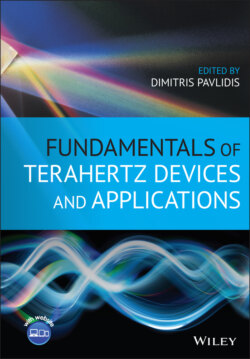Читать книгу Fundamentals of Terahertz Devices and Applications - Группа авторов - Страница 2
Table of Contents
Оглавление1 Cover
2 Title Page
3 Copyright Page
4 Dedication Page
5 About the Editor
6 List of Contributors
7 About the Companion Website
8 1 Introduction to THz Technologies
9 2 Integrated Silicon Lens Antennas at Submillimeter‐wave Frequencies 2.1 Introduction 2.2 Elliptical Lens Antennas 2.3 Extended Semi‐hemispherical Lens Antennas 2.4 Shallow Lenses Excited by Leaky Wave/Fabry–Perot Feeds 2.5 Fly‐eye Antenna Array Exercises References
10 3 Photoconductive THz Sources Driven at 1550 nm 3.1 Introduction 3.2 1550‐nm THz Photoconductive Sources 3.3 THz Metrology 3.4 THz Antenna Coupling 3.5 State of the Art in 1550‐nm Photoconductive Sources 3.6 Alternative 1550‐nm THz Photoconductive Sources 3.7 System Applications Exercises References Explanatory Notes (see superscripts in text)
11 4 THz Photomixers 4.1 Introduction 4.2 Photomixing Basics 4.3 Modeling THz Photomixers 4.4 Standard Photomixing Devices 4.5 Optical Cavity Based Photomixers 4.6 THz Antennas 4.7 Characterization of Photomixing Devices Exercises References
12 5 Plasmonics‐enhanced Photoconductive Terahertz Devices 5.1 Introduction 5.2 Photoconductive Antennas 5.3 Plasmonics‐enhanced Photoconductive Antennas 5.4 Conclusion and Outlook Exercises References
13 6 Terahertz Quantum Cascade Lasers 6.1 Introduction 6.2 Fundamentals of Intersubband Transitions 6.3 Active Material Design 6.4 Optical Waveguides and Cavities 6.5 State‐of‐the‐Art Performance and Limitations 6.6 Novel Materials Systems 6.7 Conclusion Acknowledgments Exercises References
14 7 Advanced Devices Using Two‐Dimensional Layer Technology 7.1 Graphene‐Based THz Devices 7.2 TMD Based THz Devices 7.3 Applications Exercises References
15 8 THz Plasma Field Effect Transistor Detectors 8.1 Introduction 8.2 Field Effect Transistors (FETs) and THz Plasma Oscillations 8.3 THz Detectors Based on Silicon FETs 8.4 Terahertz Detection by Graphene Plasmonic FETs 8.5 Terahertz Detection in Black‐Phosphorus Nano‐Transistors 8.6 Diamond Plasmonic THz Detectors 8.7 Conclusion Exercises References
16 9 Signal Generation by Diode Frequency Multiplication 9.1 Introduction 9.2 Bridging the Microwave to Photonics Gap with Terahertz Frequency Multipliers 9.3 A Practical Approach to the Design of Frequency Multipliers 9.4 Technology of THz Diode Frequency Multipliers 9.5 Power‐Combining at Sub‐Millimeter Wavelength 9.6 Conclusions and Perspectives Exercises References Explanatory Notes (see superscripts in text)
17 10 GaN Multipliers 10.1 Introduction 10.2 Theoretical Considerations of GaN Schottky Diode Design 10.3 Fabrication Process of GaN Schottky Diodes 10.4 Small‐signal High‐frequency Characterization of GaN Schottky Diodes 10.5 Large‐signal On‐wafer Characterization 10.6 GaN Diode Implementation for Signal Generation 10.7 Multiplier Considerations for Optimum Performance Exercises References
18 11 THz Resonant Tunneling Devices 11.1 Introduction 11.2 Principle of RTD Oscillators 11.3 Structure and Oscillation Characteristics of Fabricated RTD Oscillators 11.4 Control of Oscillation Spectrum and Frequency 11.5 Targeted Applications Exercises References
19 12 Wireless Communications in the THz Range 12.1 Introduction 12.2 Evolution of Telecoms Toward THz 12.3 THz Technologies: Transmitters, Receivers, and Basic Architecture 12.4 Devices/Function Examples for T‐Ray CMOS 12.5 THz Links 12.6 Toward Normalization of 100G Links in the THz Range 12.7 Conclusion 12.8 Acronyms E12.1 Link Budget of a THz Link References
20 13 THz Applications: Devices to Space System 13.1 Introduction 13.2 THz Heterodyne Receivers 13.3 THz Space Applications 13.4 Summary and Future Trends Acknowledgment Exercises References
21 Index
22 End User License Agreement
